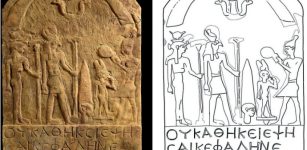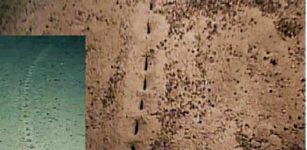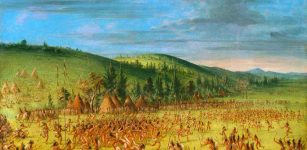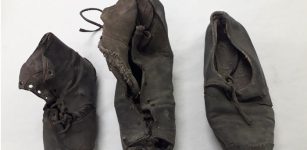Expressive Beautiful And Celebrated Bowls Created By Mimbres Artisans From Distant Past
A. Sutherland - AncientPages.com - For nearly 1100 years, in the area of the present state of New Mexico, in the mountains of Mogollon, lived a tribe of the Ancestral Mogollon people (Mimbres), one of the significant prehistoric Southwestern cultural divisions, whose lands stretched north of the Gila forest, west into Arizona, and south into northern Mexico.
Mimbres sub-group pot with geometric design. Zürich, Museum Rietberg - Public Domain
Among the Mogollon— even among contemporary Native artists - Mimbres pottery is considered the best and most impressive.
Generally, "Mimbres culture" refers to people who lived in the region and created Mimbres Black-on-white pottery and flourished from c. 200 CE to 1450 or 1540 CE, when the Spanish arrived. Also, historians have named the cultural period from 1000 to 1130 CE " Mimbres ".
"People have called the mountains, rolling hills, wide valleys, and broad desert plains of southwestern New Mexico home for at least ten thousand years. When they began to farm a little more than two thousand years ago, they settled near the rich soils in the river flood plains. Then, around 900 CE, the people of this region burned all of their kivas and started gathering in large villages with small ritual spaces and open plazas. Between about 900 and 1100 CE, they also made intricately painted geometric and figurative bowls in a style called Mimbres, their best-known legacy today. In the 1130s, they stopped making this pottery and drifted out of villages to more dispersed settlements..."
The book "Mimbres Lives and Landscapes" written by Margaret C. Nelson & Michelle
Hegmon contributes with answers to important questions regarding the ancient Native American culture of the Mimbres.
The Mimbres - Amazing Artists
The Mimbres (in Spanish: “willows”) are most famous for their specific and very beautiful pottery. A thousand years ago, village farmers in the Mimbres Valley of what is now southwestern New Mexico created stunning black-on-white pottery.
The talented artisans of Mimbres decorated their ceramic items with imaginative designs of birds, insects, fishes, and various animals, from omnipresent rabbits to mythical creatures, geometric lines, and scenes of everyday life.
Mimbres bowls at Stanford University. Mimbres pottery, New Mexico, U.S.
Iris & B. Gerald Cantor Center for Visual Arts Image credit: 2006 David Monniaux - CC BY-SA 3.0
Intricately painted geometric and figurative bowls represent the best-known legacy of these Native Americans, who left the most vivid graphic record of their religious beliefs and spiritual visions on stone and ceramic surfaces.
This art has contributed with a fascinating, ever-lasting accent to southwestern archaeology.
Ritual Of "Killing The Bowl" And Beautiful Pottery
The Mimbres left, but their cave houses remained, where, according to the ancient Native American tradition, they used to hide their deceased under the floor. The practice was to bury the dead in the fetal position with a bowl placed above the head of the deceased. Before the bowl was placed in the prescribed place (commonly found covering the face of the interred person), the so-called ritual of "killing the bowl" occurred by punching a small hole.
Almost all Mimbres bowls found have such holes. Further archaeological evidence showed that many pottery items were not buried with the dead as funerary goods and used for other purposes.
The bowls of Mimbres were decorated with geometric patterns, dark on a pale background. Unfortunately, it is not precisely known what they were supposed to symbolize.
Mimbres bowls - undoubtedly the most perfect examples of prehistoric American ceramics. Image source
On some bowls, we see people turning into animals or animals turning into people. On the other, Mimbres bowls are painted fantastic beasts. One example would be strange mammals with the tail of a fish or the wings of a bird.
The Mogollons did not use a potter's wheel. They shaped the bowls, overlapping one on top of the other - twisted braids of wet clay, then smoothed the whole thing by tucking gourds. Only the interiors of the bowls were decorated with brushes made of yucca fibers. Because Mimbres bowls - undoubtedly the most perfect examples of prehistoric American ceramics - are trendy among the collectors.
Abandoning Of Mimbres
The western Mogollon peoples began abandoning their communities in several areas in southeastern Arizona and southwestern Mexico early in the 12th century. They had left the Mimbres area by the 13th century.
The fact remains that after 1300, the Mogollons disappeared, which is difficult to explain.
Did the Mogollons emigrate because of drought?
Or did they become extinct due to devastating wars or some terrible calamity? Many archaeologists also suggested other reasons like warfare, disease, resource exhaustion, religious system collapse, greener grazing areas, or even a mixture of these reasons.
In the 1130s, they stopped making beautiful pottery and drifted out of villages. Some stayed until the early 15th century. Most probably, many of them joined the western pueblos which existed into historic times, for instance, those of the Hopi and Zuni.
Written by – A. Sutherland - AncientPages.com Senior Staff Writer
Copyright © AncientPages.com All rights reserved. This material may not be published, broadcast, rewritten or redistributed in whole or part without thexpress written permission of AncientPages.com
Expand for referencesReferences:
Margaret C. Nelson / Michelle Hegmon, Mimbres Lives and Landscapes
Hegmon, M. (2016). Ceramics: Mimbres Pottery. In: Selin, H. (eds) Encyclopaedia of the History of Science, Technology, and Medicine in Non-Western Cultures. Springer, Dordrecht. https://doi.org/10.1007/978-94-007-7747-7_8793
More From Ancient Pages
-
 Capoeira: Ancient Martial Art Disguised As A Dance Became A Symbol Of Resistance To Oppression
Ancient History Facts | Jun 8, 2018
Capoeira: Ancient Martial Art Disguised As A Dance Became A Symbol Of Resistance To Oppression
Ancient History Facts | Jun 8, 2018 -
 Shrine Discovered In Egyptian Temple And Evidence Of Previously Unknown Rituals
Archaeology | Oct 6, 2022
Shrine Discovered In Egyptian Temple And Evidence Of Previously Unknown Rituals
Archaeology | Oct 6, 2022 -
 Who Or What Made These Mysterious Holes At The Bottom Of The Atlantic Ocean?
News | Mar 23, 2023
Who Or What Made These Mysterious Holes At The Bottom Of The Atlantic Ocean?
News | Mar 23, 2023 -
 Lacrosse Was Invented By Native American Indians
Ancient History Facts | May 1, 2016
Lacrosse Was Invented By Native American Indians
Ancient History Facts | May 1, 2016 -
 A 200-Year-Old Swedish Mystery Remains Unsolved
Ancient Mysteries | Oct 7, 2015
A 200-Year-Old Swedish Mystery Remains Unsolved
Ancient Mysteries | Oct 7, 2015 -
 Rock Stars: How A Group Of Scientists In South Africa Rescued A Rare 500 Kg Chunk Of Human History
Featured Stories | Oct 20, 2022
Rock Stars: How A Group Of Scientists In South Africa Rescued A Rare 500 Kg Chunk Of Human History
Featured Stories | Oct 20, 2022 -
 Rare Viking Ship Burial At Gamla Uppsala Reveals Its Secrets – What’s Inside?
Archaeology | Aug 8, 2020
Rare Viking Ship Burial At Gamla Uppsala Reveals Its Secrets – What’s Inside?
Archaeology | Aug 8, 2020 -
 Cannabis Protected India’s Famous Ellora Caves From Decay For 1,500 Years
Archaeology | Mar 12, 2016
Cannabis Protected India’s Famous Ellora Caves From Decay For 1,500 Years
Archaeology | Mar 12, 2016 -
 Baffling Cathar Mystery – Was It A Double Ancient Reincarnation Case?
Featured Stories | Jan 12, 2025
Baffling Cathar Mystery – Was It A Double Ancient Reincarnation Case?
Featured Stories | Jan 12, 2025 -
 Piecing Together Scotland’s Religious Past With Shards Of Glass
Archaeology | Feb 28, 2023
Piecing Together Scotland’s Religious Past With Shards Of Glass
Archaeology | Feb 28, 2023 -
 On This Day In History: ‘The Wars Of The Roses’ – Fighting For The Throne Of England At Tewkesbury – On May 4, 1471
News | May 4, 2016
On This Day In History: ‘The Wars Of The Roses’ – Fighting For The Throne Of England At Tewkesbury – On May 4, 1471
News | May 4, 2016 -
 Peculiar Ancient Stone Disk Could Be World’s Oldest Celestial Map
Archaeology | Jan 3, 2024
Peculiar Ancient Stone Disk Could Be World’s Oldest Celestial Map
Archaeology | Jan 3, 2024 -
 Patara Lighthouse Built By Emperor Nero In 64 AD Will Shine Again
Archaeology | Mar 5, 2020
Patara Lighthouse Built By Emperor Nero In 64 AD Will Shine Again
Archaeology | Mar 5, 2020 -
 Tikal Of Maya: Sophisticated Culture That Experienced Humble Start, Golden Age, Wars And Decline
Featured Stories | Apr 4, 2022
Tikal Of Maya: Sophisticated Culture That Experienced Humble Start, Golden Age, Wars And Decline
Featured Stories | Apr 4, 2022 -
 Legendary Saraswati River Is Not A Legend – It Existed 4,000 Years Ago
Archaeology | Mar 18, 2017
Legendary Saraswati River Is Not A Legend – It Existed 4,000 Years Ago
Archaeology | Mar 18, 2017 -
 Strange Encounter With A Dead Medieval Army In Normandy – Or Were They Visitors From A Parallel World?
Featured Stories | Nov 5, 2017
Strange Encounter With A Dead Medieval Army In Normandy – Or Were They Visitors From A Parallel World?
Featured Stories | Nov 5, 2017 -
 Only One In Four Western Roman Emperors Died Of Natural Causes
Archaeology | Oct 15, 2021
Only One In Four Western Roman Emperors Died Of Natural Causes
Archaeology | Oct 15, 2021 -
 Unique 1,300-Year-Old Pala Period Idol Of Snake Goddess, Nag Devi Discovered Near Nalanda University, India
Archaeology | Apr 5, 2022
Unique 1,300-Year-Old Pala Period Idol Of Snake Goddess, Nag Devi Discovered Near Nalanda University, India
Archaeology | Apr 5, 2022 -
 Mystery Of The Hidden Shoes Discovered In Ancient European Houses – What Is Behind This Bizarre Tradition?
Featured Stories | Oct 2, 2021
Mystery Of The Hidden Shoes Discovered In Ancient European Houses – What Is Behind This Bizarre Tradition?
Featured Stories | Oct 2, 2021 -
 Izanagi and Izanami And World Creation In Shinto Cosmology
Featured Stories | Mar 28, 2019
Izanagi and Izanami And World Creation In Shinto Cosmology
Featured Stories | Mar 28, 2019



